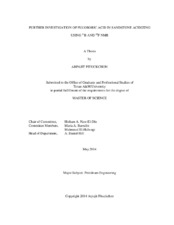| dc.description.abstract | Although fluoboric acid (HBF_(4)) has long been known as one of the low-damaging acid treatments for clayey sandstone formations, little is known of its chemistry which could explain the mixed results of fluoboric acid in actual field application. A better understanding of its limitations would contribute to an improved success rate in HBF_(4) stimulation application.
The unique advantages of this acid system are the ability to reach deeper into formation to address damage at extended radius before spending, owing to its slow hydrolytic reaction to produce HF, as well as the stabilization and desensitization of undissolved fines with borosilicate.
A more comprehensive understanding of how the chemistry of fluoboric acid and its reaction products affect silica and aluminosilicates is crucial to the design and optimization of fluoboric acidizing treatment. Through a novel application of ^(11)B and ^(19)F Solution State High Field Nuclear Magnetic Resonance (NMR) spectroscopy, chemical complexes involved in the reaction were defined.
Various other experimental techniques were also employed in studies on the ability of hydrolyzed fluoboric acid to react with common clays found in sandstone at room and elevated temperatures, as well as coreflooding to investigate clay migration development. Analyzing fresh and spent acid with inductively coupled plasma (ICP) and ^(11)B and ^(19)F NMR helps identify reaction products and their distribution. A set of 12-3 mud acid experiments was done in parallel to serve as a reference to 3%- equivalent-HF fluoboric acid in aqueous-HCl solution.
NMR results show complex mixtures of fluoborate species from HBF_(4) hydrolysis and products from HF-aluminosilicates reaction. The fresh HB_(F4) hydrolysis study at room temperature has confirmed retarded HF generation with presence of BF_(4)- and BF_(3)(OH)- and absence of BF_(2)(OH)_(2)- or BF(OH)_(3)- species . The effect of temperature on HBF4 reaction has also been studied to validate functionality of acid at 75°F and 200°F. A series of lab dynamic flow testing in Berea sandstone corroborates conclusions from lab experiments by showing decrease in permeability when treating Berea sandstone cores with HBF_(4) at 200°F. Fluoboric acid treatment is therefore not suitable for formations with approximate temperature of 200°F. | en |


